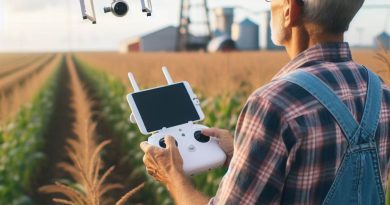Biofortified Foods: A Genetic Revolution
Last Updated on March 2, 2024
Introduction
From ancient times humanity has manipulated plant genetics to improve yields, but modern biotechnology grants unprecedented precision in the developing field of biofortification.
By enriching staple crops with essential micronutrients absent in normal varieties, biofortified foods hold promise to naturally combat malnutrition afflicting low-income regions.
Overview of the genetic revolution in agriculture
Breakthroughs in genetic sequencing and gene splicing today enable direct enhancement of nutritional density in crops while retaining other favorable qualities.
Key target nutrients lacking in common diets worldwide include iron, zinc, and vitamin A.
Early successes delivering these micronutrients in cassava, beans, sweet potatoes and other staple foods already benefit vulnerable populations in Africa and Asia.
As biofortification initiatives progress from laboratories to farms to plates globally, this genetic revolution aims to permanently address malnutrition affecting over 2 billion.
Additionally, the improved economic viability and yields of biofortified strains provide farmer incentives for adoption.
However, realizing lasting impacts requires continued research and funding alongside thoughtful regulation and safety validation to earn consumer trust.
Purpose of the blog post
This blog post tracks the biofortified frontier’s progress towards a future of more nutritious, resilient crop varieties.
Key topics include evaluating techniques for genetic enhancement in labs and fields, analyzing costs versus benefits, and projecting case studies from early adoption areas.
The agricultural era ahead indeed looks bright.
Understanding Biofortification
Biofortification and its purpose
Biofortification is the process of enhancing the nutrient content of crops to address malnutrition.
Various techniques used for biofortification
- Conventional breeding methods: Traditional crossbreeding to select plants with desired nutritional traits.
- Genetic engineering: Modifying plant DNA to enhance nutrient content and bioavailability.
Examples of biofortified crops
- Golden Rice: Genetically modified to produce beta-carotene, a precursor of vitamin A.
- Iron-rich beans: Developed through traditional breeding to contain higher levels of iron.
- Vitamin A-fortified sweet potatoes: Increased beta-carotene content to combat vitamin A deficiency.
Biofortification offers a promising solution to combat nutritional deficiencies and improve public health.
Read: Aquaponics: A Sustainable Food Production System
Benefits of Biofortified Foods
Improved nutritional content
- Biofortified foods are genetically engineered to have enhanced levels of essential nutrients.
- They provide a more efficient way to address nutrient deficiencies in the modern diet.
- These foods can be tailored to meet specific nutritional needs, improving overall health.
Global micronutrient deficiencies
- Biofortification targets specific minerals and vitamins that are lacking in certain populations.
- It offers a sustainable solution to combat malnutrition on a global scale.
- By increasing the nutrient content in staple crops, it can reach large populations easily.
Enhancing human health
- Biofortified foods have the potential to reduce vitamin deficiencies and associated health problems.
- By consuming these foods, individuals can improve their immune system and overall well-being.
- Regular intake of biofortified foods can contribute to healthier populations with improved cognitive function.
Potential economic advantages for farmers and communities
- Biofortification offers economic opportunities for farmers by producing value-added crops.
- Farmers can earn higher incomes by investing in biofortified crop production.
- This technology can also boost local economies by creating additional jobs and promoting agricultural development.
Biofortified foods hold immense potential in addressing global malnutrition and improving human health.
By enhancing the nutritional content of staple crops, biofortification offers a sustainable and cost-effective solution to micronutrient deficiencies.
Moreover, the economic advantages associated with biofortified crop production can benefit farmers and communities alike.
As technology advances, biofortification promises to revolutionize food production and contribute to a healthier and more prosperous future.
Read: Food Safety Laws: Impact on Farmers
Uncover the Details: Smart Farming: The Rise of Agri Robots
Challenges and Controversies
Safety concerns and regulatory measures
- Genetic engineering raises safety concerns, as critics worry about potential risks to human health.
- Strict regulatory measures are necessary to assess the safety and efficacy of biofortified foods.
- Independent research studies and testing protocols need to be conducted to ensure their safety.
- Regulatory agencies play a crucial role in monitoring and overseeing the production and distribution of genetically modified foods.
- Stringent labeling requirements are important to inform consumers and allow them to make informed choices.
Opposition to genetic engineering and GMOs
- Opponents argue that genetically modified organisms (GMOs) pose a threat to biodiversity and ecological balance.
- Concerns about the environmental impact of GMOs include gene flow to wild populations and the creation of superweeds.
- Some consumer groups advocate for mandatory labeling of GMOs to promote transparency and consumer rights.
- Critics argue that GMOs have not been adequately tested for long-term effects on human health.
- Evidence-based research and open dialogues between scientists, policymakers, and the public are essential to address concerns.
Ethical considerations and socio-economic implications
- Introducing biofortified foods raises ethical questions regarding the potential exploitation of small-scale farmers and indigenous communities.
- There is a concern that large corporations could dominate the industry, creating a socio-economic imbalance.
- Access to biofortified foods should be equitable, ensuring they reach vulnerable populations and not just wealthier consumers.
- Intellectual property rights and patent issues may limit the availability and affordability of biofortified crops.
- Participatory approaches involving local communities and stakeholders are crucial for addressing ethical and socio-economic concerns.
Biofortified foods and genetic engineering hold great promise for addressing the global challenges of malnutrition and food security.
However, their implementation is not without challenges and controversies.
Safety concerns related to potential risks to human health have been raised, emphasizing the need for strict regulatory measures.
Independent research studies and testing protocols are crucial to ensuring the safety of these foods.
Opposition to genetic engineering and GMOs stems from concerns about the environmental impact, including the potential threat to biodiversity and ecological balance.
Critics argue for mandatory labeling of GMOs and highlight the importance of long-term studies on human health effects.
Open dialogues and evidence-based research are essential for addressing these concerns.
Ethical considerations
Introducing biofortified foods also raises ethical considerations.
There are worries about the exploitation of small-scale farmers and indigenous communities, as well as the potential dominance of large corporations in the industry.
Equitable access to these foods is vital, ensuring they reach vulnerable populations.
Socio-economic implications, such as intellectual property rights and patent issues, may limit the availability and affordability of biofortified crops.
It is crucial to involve local communities and stakeholders in decision-making processes to address ethical and socio-economic concerns.
In general, while biofortified foods offer a genetic revolution in combating malnutrition, safety concerns, opposition to genetic engineering, ethical considerations, and socio-economic implications pose challenges and controversies.
Addressing these issues through rigorous regulation, evidence-based research, transparency, and inclusive decision-making processes is essential to make progress in this field.
Read: Farmers Markets: Your Local Food Hub

You Might Also Like: Smart Farming: The Rise of Agri Robots
Success Stories and Future Prospects
Positive outcomes in developing countries
- In countries like Uganda and Mozambique, biofortified crops have shown promising results.
- Vitamin A-rich orange maize has been successfully introduced in Uganda, reducing malnutrition and improving health.
- Iron and zinc fortified beans have also been embraced, providing a sustainable solution to nutrient deficiencies.
Partnerships and initiatives promoting biofortification
- Global organizations like HarvestPlus, the CGIAR Research Program on Agriculture for Nutrition and Health, and the WHO have been instrumental in driving biofortification forward.
- These partnerships bring together scientists, farmers, policymakers, and consumers to ensure the success of biofortified foods.
- Initiatives like the Biofortified Crops for Africa Program promote the development and dissemination of biofortified crops.
Expanding the reach of biofortified foods
- Efforts are being made to increase accessibility and availability of biofortified foods through local markets and government programs.
- Nutrition education programs aim to create awareness about the benefits of biofortified crops and encourage their consumption.
- Public-private partnerships play a crucial role in scaling up production and distribution of biofortified foods.
Potential for biofortification in addressing climate change challenges
- Biofortification can contribute to climate change adaptation by developing climate-smart crops.
- Drought-tolerant and disease-resistant biofortified varieties can help farmers cope with changing environmental conditions.
- By enhancing crop resilience and reducing vulnerability, biofortification can foster food security in the face of climate change.
In essence, the success stories surrounding biofortified foods in developing countries highlight the tremendous potential of this genetic revolution.
Positive outcomes have been observed through the introduction of biofortified crops, such as vitamin A-rich maize and iron-fortified beans, reducing malnutrition and improving health.
Partnerships and initiatives, led by organizations like HarvestPlus and the CGIAR Research Program, have played a crucial role in promoting biofortification globally.
Efforts to expand the reach of biofortified foods through local markets, education programs, and public-private partnerships are underway.
Additionally, biofortification can address climate change challenges by developing climate-smart crops that can withstand environmental changes.
Overall, biofortification offers a promising solution for addressing nutrient deficiencies and building resilience in the face of a changing world.
Read: Farmers’ Stories: Voices Behind Your Food
Conclusion
Recap of the benefits and potential of biofortified foods
Biofortified foods offer tremendous potential in addressing malnutrition and improving public health.
By enriching staple crops with essential nutrients, they can provide a cost-effective and sustainable solution to address micronutrient deficiencies.
Encouragement for further research and adoption
To fully realize the benefits of biofortified foods, continued research is necessary to refine the breeding techniques and enhance nutritional content.
It is crucial to encourage widespread adoption of these crops, especially in regions where malnutrition is prevalent.
Call to action for supporting biofortification efforts
It is our responsibility to support biofortification efforts by advocating for policy changes and funding research initiatives.
By collaborating with researchers, farmers, and policymakers, we can ensure that biofortified foods reach those who need them the most.
By incorporating biofortified foods into our diets and supporting initiatives that promote their growth, we can contribute to a healthier future for all.
Together, let’s embrace the genetic revolution and nourish our communities with biofortified foods.


